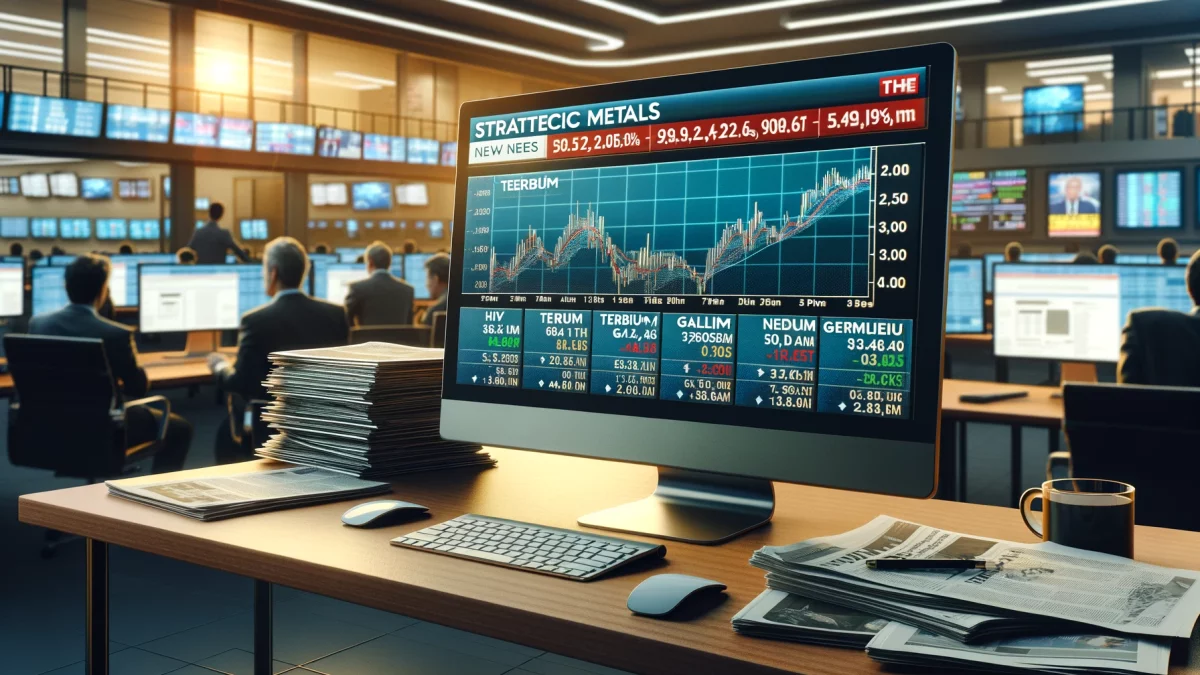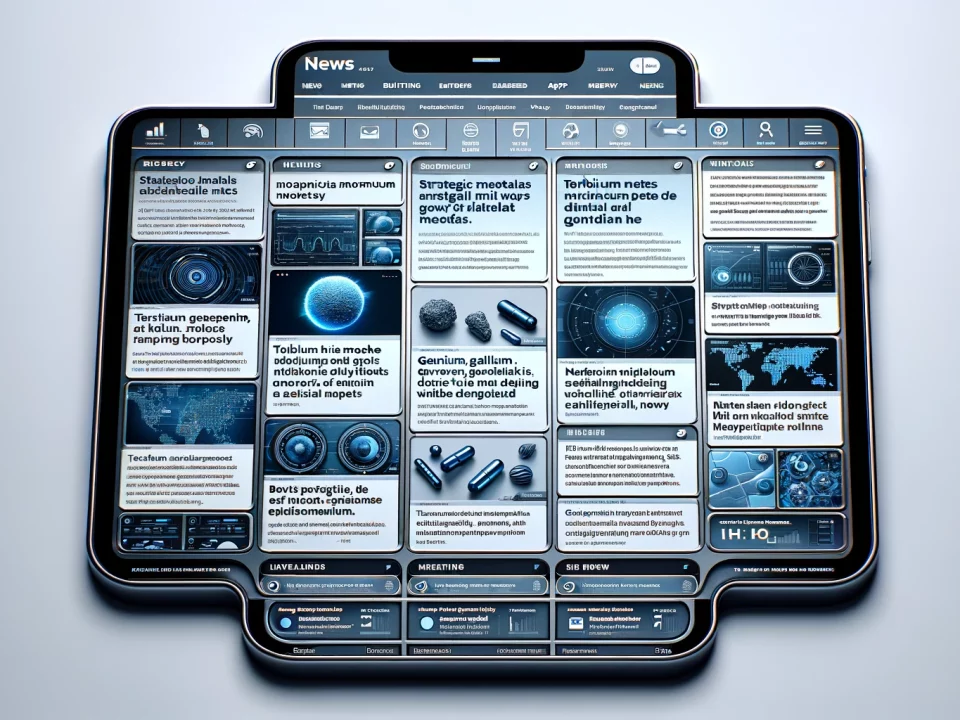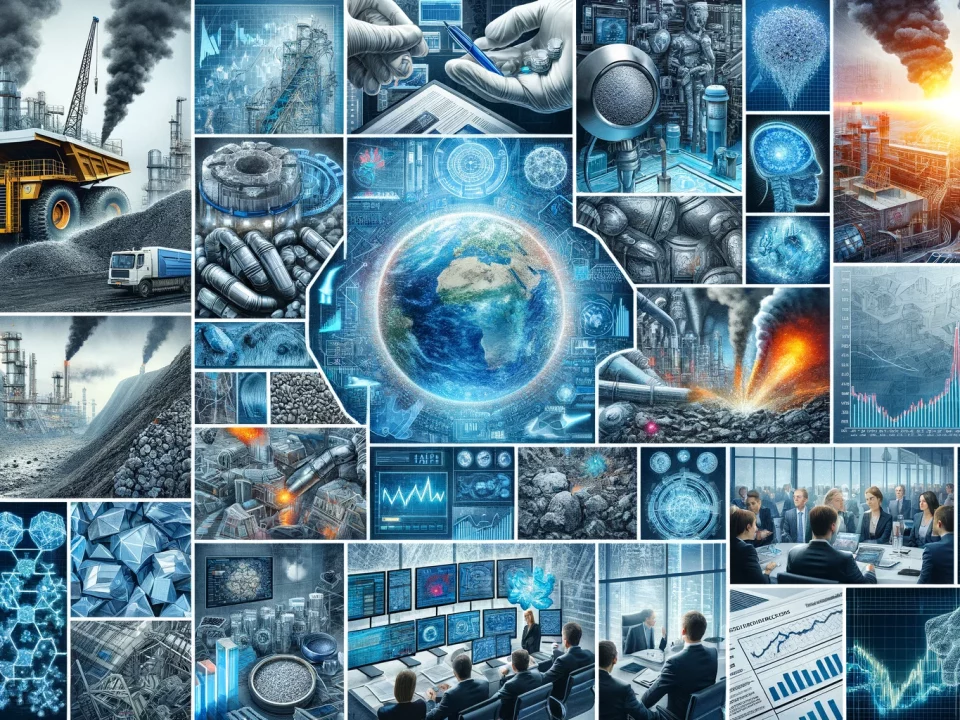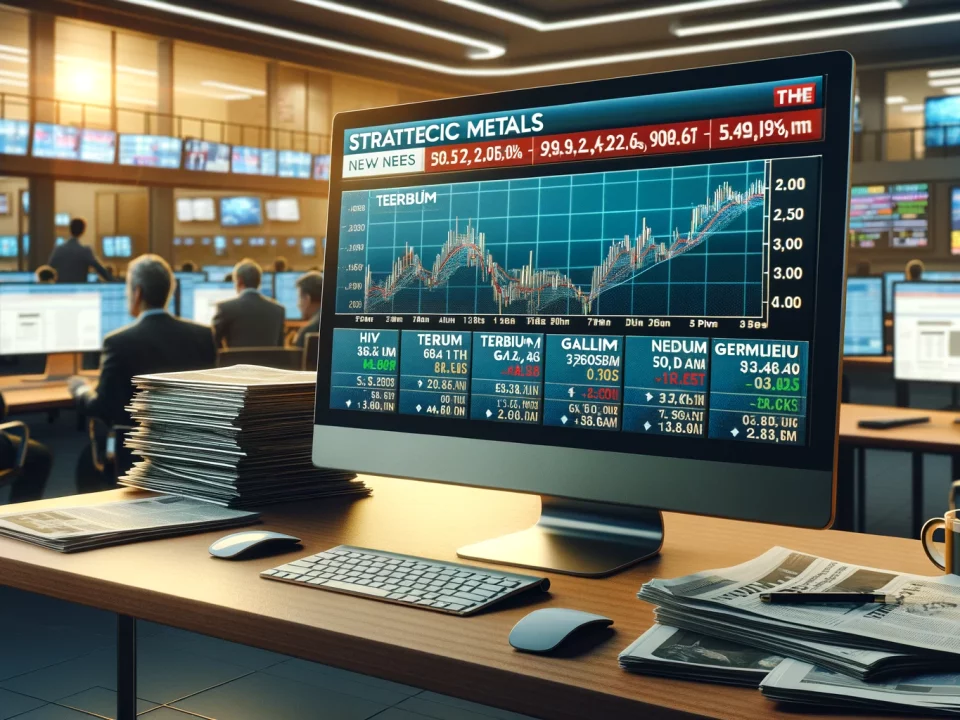Terbium Price Forecast 2025: Why This Rare Earth is Poised for a Rebound
November 12, 2024
Weekly News Review November 18 – November 24 2024
November 24, 2024This week, the German industry held a high-level meeting in Berlin regarding raw material resilience. The core event was the publication of a study on Germany’s dependence on raw material imports. Meanwhile, Aclara Resources and Neo Performance Materials, two companies in the critical minerals sector, made significant announcements….
….all the details are in our weekly roundup.
EUROPE: STRATEGIC METALS DEPENDENCY IS A BILLION-EURO RISK FOR GERMANY’S ECONOMY –
Germany’s industry relies heavily on mineral resources—many of which need to be imported, often from just a few producing countries. This dependency poses an increasing risk to supply security, growth, and prosperity, as highlighted in a recent study by consulting firm Roland Berger and the Federation of German Industries (BDI).
The authors cite the potential disruption of China’s role as the leading supplier of lithium and lithium products like batteries as an example. Such a disruption could lead to a loss of up to €115 billion in value creation, including €42 billion in the automotive industry alone.
Moreover, BDI President Siegfried Russwurm explains that Germany’s reliance on raw material imports has grown in recent years despite the widespread awareness of the issue and efforts to reduce it. For instance, 32% of rare earth imports came from China in 2014, but by 2023, this figure had risen to 69%. Similarly, Germanium imports from China increased from 23% to 40%.
The authors recommend various measures to address this challenge, including domestic raw material extraction and processing and diversifying supplier countries. Initiatives such as the EU’s Global Gateway strategy for promoting foreign infrastructure projects should be utilized more effectively in building new partnerships.
Additionally, the circular economy and technological innovations in recycling need to be strengthened. To maintain international competitiveness, new forms of raw material sourcing, such as deep-sea mining and space mining, should also be explored.
With Germany’s import dependency on raw materials increasingly in focus due to ongoing global crises, more studies have addressed the issue. In September, the BDI warned of potential deindustrialization and called for “bold measures” to secure critical resources. The association’s Raw Materials Congress, taking place today, will examine Germany’s progress on raw material sovereignty two years after the so-called “Zeitenwende.”
RARE EARTHS: ARE WE ON THE VERGE OF SUPERCONDUCTIVITY:
Faster power grids and computers, nuclear fusion, fully electric aircraft – new materials with lutetium, yttrium, and other critical minerals could pave the way for technological innovation.
Superconductors are metals and compounds through which electricity can flow without electrical resistance and, therefore, almost without loss. Their potential is vast—they could make power grids, electric motors, maglev trains, computer chips, and much more significantly more efficient. But there’s a catch: to function, superconducting materials must be cooled to temperatures far below 100 degrees Celsius under extreme pressure. This has limited their application, such as in MRI machines and the development of quantum computers.
Worldwide, scientists are searching for superconductors that can operate at room temperature and under ambient pressure. In 2023, a study made waves, claiming this was achieved with a compound of nitrogen, hydrogen, and lutetium, a rare earth element. However, the findings were controversial, and the study, published in Nature, was later retracted. For lead researcher Ranga Dias, this marked the third retraction of a publication. A veritable scandal emerged over the results.
However, the controversy inspired Adam Denchfield, a doctoral student in physics at the University of Illinois, Chicago, to conduct his research. By reviewing studies from the late 1960s on the material in question—rare-earth trihydrides—he found indications of potential superconductivity at comparatively high temperatures, depending on the atomic arrangement.
THE “HOLY GRAIL” OF SUPERCONDUCTIVITY:
Based on these insights, Denchfield and other scientists conducted various experiments, ultimately developing three promising material designs. They also tested replacing lutetium with other rare earth elements like yttrium and scandium to increase efficiency further. According to the researchers, the final designs exhibited superconducting properties at about -73 degrees Celsius. Computer simulations suggest they could even achieve superconductivity at ambient pressure and room temperature—something Denchfield compares to discovering the “Holy Grail.”
The materials now need to be synthesized and tested in the lab to verify these projections. Additionally, Denchfield intends for this work to inspire other researchers. The findings could spark the search for a “completely new class of structures” that could serve as potential high-temperature superconductors, paving the way for groundbreaking technological innovations.
UNITED STATES: DEPT. OF COMMERCE TO SUPPORT CHILEAN MINING COMPANY IN FINDING SUITABLE LOCATION FOR RARE EARTHS SEPARATION PLANT –
Chilean mining company Aclara Resources announced Wednesday that the United States Department of Commerce will help it find a suitable location for its planned rare earth separation plant. The Department’s International Trade Administration will study financial incentives, infrastructure, permitting and regulatory environment, and other criteria to determine the optimal location within the U.S.
Aclara is developing so-called ion-adsorption clay rare earth projects in Chile and Brazil. These deposits contain higher concentrations of heavy rare earth elements than other types. However, they are currently only mined in China and neighboring Myanmar. Heavy rare earths increase the performance of magnets and are indispensable for state-of-the-art permanent magnets used in fields like electric vehicles or wind turbines.
In April, Aclara unveiled plans to construct a rare earth separation plant in the U.S. to integrate downstream processing of the rare earth value chain vertically. The company seeks to process the material mined in South America in North America.
Additionally, in July, Aclara signed a strategic partnership with German magnet maker Vacuumschmelze, which is building a production facility in the U.S. A possible supply agreement could finalize a mine-to-magnet value chain from South to North America.
NEW YORK: MAKING STRATEGIC METALS MINING MORE EFFICIENT –
How do microorganisms interact with minerals, and how can this be harnessed for eco-friendly extraction? A project from Cornell University could bring answers.
Processing critical resources like rare earth elements is complex and requires using a wide range of chemicals, which, if improperly handled, can cause significant environmental damage. International research is underway to address this and develop alternative methods. One challenge is that many approaches need to be more scalable to an economic level.
This also applies to the extraction of minerals from ores and their subsequent concentration using microbes, a process known as biomining. Led by Cornell University in New York, an international team of scientists aims to change this. The team plans to create a “Microbe-Mineral Atlas,” which will include specific genes and catalog their interaction with minerals.
This could help create genetically engineered microorganisms for practical applications. The team will also explore whether and how regulatory guidelines must be adapted to accommodate this new form of biotechnology. Additionally, collaboration with secondary schools will ease concerns among future employees in the sector regarding genetic technologies.
A $2 million grant from the National Science Foundation supports the creation of the atlas. In the past, the U.S. Department of Energy has also shown interest in and provided funding for the research of lead scientist Buz Barstow.
GERMANY: INDUSTRY CONFERENCE HIGHLIGHTS THE NEED FOR MORE RESILIENCE –
Under the theme “Daring More Resource Sovereignty,” the Federation of German Industries (BDI) hosted its eighth Raw Materials Congress this week. Around 200 political and industry participants and numerous media representatives accepted the invitation to the former army bakery in Berlin.
Before BDI President Siegfried Russwurm’s official opening, participants could choose one of three parallel “Focus Sessions,” featuring short presentations and discussions. One session explored how the African continent can establish itself as a supplier of raw materials and how German companies can build partnerships locally.
A recurring theme emphasized in later presentations was the need to create added value in target countries for investments. This includes collaborating with local communities, building infrastructure, and fostering technological partnerships. Transparency was another crucial factor, highlighted by the Ambassador of the Democratic Republic of the Congo, Louise Nzanga Ramazani, who emphasized the importance of traceability and certification of raw materials.
The “Innovations in Raw Materials Supply” session examined alternatives to traditional mining. Alongside AI, secondary mining—extracting resources from residuals like tailing dumps—and deep-sea mining for critical resources were discussed.
Although Germany has signed a moratorium, studies on the opportunities and risks of deep-sea mining continue. In 2026, the Federal Institute for Geosciences and Natural Resources (BGR) plans the subsequent test explorations in the Clarion-Clipperton Zone to assess impacts on the seafloor fauna.
There was no empty seat in the hall as BDI President Russwurm reflected on the developments in raw materials policy since the last congress two years ago. His review was mixed. Positive examples include the EU’s Critical Raw Materials Act (CRMA), various raw materials partnerships, and the German Raw Materials Fund, though Germany’s Federal Mining Act has yet to be modernized.
Such modernization could support the CRMA goals and act as a “booster” for national implementation. However, Russwurm warned that, in contrast to global competitors like China, Germany is acting “too little, too late.” A study published at the conference highlights this on a dramatic hypothetical event: were China to suddenly halt lithium exports, Germany would face a multi-billion-euro economic impact.
Importance of Raw Material Supply Still Not Widely Recognized:
The significance of raw materials must be understood not only in politics but also across society, or new projects risk being blocked. Rather than phasing out certain industries, Germany needs to reinvest in resource extraction and processing. Russwurm commended Franziska Brantner, Parliamentary State Secretary at the Federal Ministry for Economic Affairs and Climate Action, who later shared her perspective.
While dependency on China has increased, reliance on Russia for metals has significantly decreased. Brantner argued not for autarky in critical raw materials but rather for raw material partnerships.
KAZAKHSTAN AIMS TO ENHANCE GLOBAL POSITION:
Government meeting discusses ways to ramp up mining and processing sectors.
Kazakhstan plans to expand its global share in critical mineral production. According to the Astana Times, Kazakh Prime Minister Olzhas Bektenov chaired a weekly government meeting to discuss the country’s international position in the sector and ways to enhance it. Besides ramping up mining activities, the Central Asian country will examine building up permanent magnet, recycling, and heat-resistant alloy production capacities.
Amidst Western efforts to diversify supply chains away from industry leader China, resource-rich Kazakhstan is becoming increasingly relevant. Multiple countries, including Germany and South Korea, have signed cooperation agreements with Kazakhstan.
This week, Kanat Sharlapaev, Kazakh Minister of Industry and Construction, spoke at the Raw Materials Congress of the German Federation of German Industries (BDI) in Berlin, highlighting the opportunities the Central Asian resource sector presents for allied nations. Sharlapaev emphasized that the country has been a reliable partner for energy, which could be expanded to other raw materials. In December, the minister highlighted in an interview that Kazakhstan produces 18 of 34 minerals classified as critical by the EU.
Last week, Kazakhstan and South Korea announced intensified cooperation in critical minerals and other fields.
AUSTRALIA: POSITIVE OUTLOOK FOR ENERGY TRANSITION RAW MATERIALS –
Australia’s mining industry is traditionally strong, contributing nearly 14 percent to the country’s GDP—twice as much as Canada, another resource-rich nation. In addition to coal, iron, and gold, critical raw materials are also attracting international interest as the demand for rare earth elements and lithium grows, along with dependence on resource giant China. What is the industry’s current state in Australia, and can the country’s mining companies benefit from the booming demand for critical resources?
The annual report from consulting firm PwC answers these questions, analyzing the current situation of the 50 mid-sized Australian mining companies (MT50). The market capitalization of these companies is significantly smaller than that of international corporations based in Australia, such as BHP or Rio Tinto. The MT50 includes, among others, the gold producer Northern Star Resources Limited and companies specializing in rare earths like Lynas and Iluka Resources.
Significant Gap Between Potential and Number of Investment-Ready Projects:
One finding of the PwC report is that the MT50 is becoming more gold-focused, with gold companies now contributing nearly half of the operating cash flow. Meanwhile, the critical minerals sector has significantly lost its share of the total MT50 value. While it was 52 percent last year, it is currently only 37 percent.
Despite this setback, the outlook remains positive, as demand will continue to rise due to green technologies. To benefit from this trend, private capital must be mobilized, and mining clusters must be developed. Many projects need to be more significant to attract investments: One-fifth of the current critical minerals projects are considered investment-ready by PwC.
CANADA: NEO PERFORMANCE MATERIALS POSTS DECLINE IN REVENUE, INCREASED PROFITS FOR THIRD QUARTER –
Decline in revenue, increased operating profit. The rare metals division performed stronger than last year.
Toronto-based Neo Performance Materials reported figures for the third quarter on Thursday, revealing a mixed bag: While overall revenue declined compared to the same period last year, the company specializing in advanced industrial materials increased its operating income and the adjusted EBITDA. The figures show that the rare metals division performed significantly more potent than in 2023 despite a challenging market environment for rare earths. Additionally, Magnequench, the company’s magnetic products division, achieved its highest quarterly volume of the year, driven by traction motor sales and spot demand in bonded powder, the company said.
Neo’s President and Chief Executive Officer Rahim Suleman emphasized that the “performance, driven by growth in our Magnequench and Rare Metals business units, reaffirms our business strategy and approach.” Earlier this year, Neo began divesting unprofitable business units, including two in China (we reported).
In the statement, Neo also reported on recent developments: The construction of its sintered rare earth magnet plant in Estonia is nearing completion, and the company secured a $50 million credit facility from Export Development Canada, with a five-year term to support final construction, equipment purchases and commissioning of the facility.






